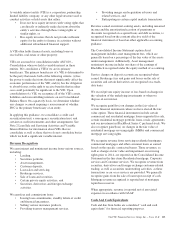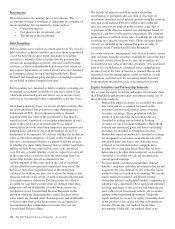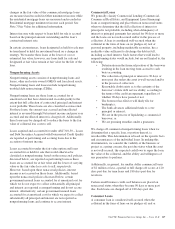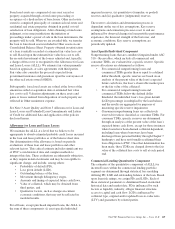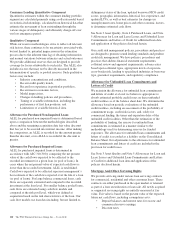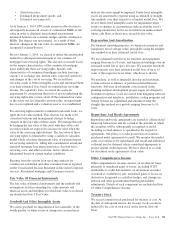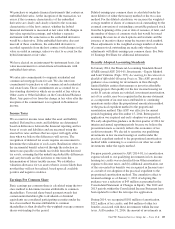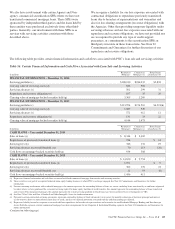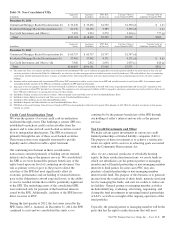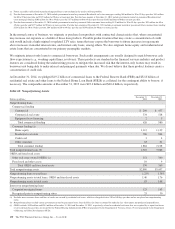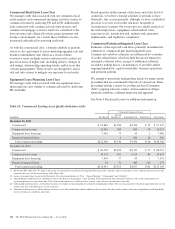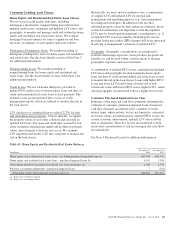PNC Bank 2014 Annual Report Download - page 141
Download and view the complete annual report
Please find page 141 of the 2014 PNC Bank annual report below. You can navigate through the pages in the report by either clicking on the pages listed below, or by using the keyword search tool below to find specific information within the annual report.
We purchase or originate financial instruments that contain an
embedded derivative. At the inception of the transaction, we
assess if the economic characteristics of the embedded
derivative are clearly and closely related to the economic
characteristics of the host contract, whether the hybrid
financial instrument is measured at fair value with changes in
fair value reported in earnings, and whether a separate
instrument with the same terms as the embedded derivative
would be a derivative. If the embedded derivative does not
meet all of these conditions, the embedded derivative is
recorded separately from the host contract with changes in fair
value recorded in earnings, unless we elect to account for the
hybrid instrument at fair value.
We have elected on an instrument-by-instrument basis, fair
value measurement for certain financial instruments with
embedded derivatives.
We enter into commitments to originate residential and
commercial mortgage loans for sale. We also enter into
commitments to purchase or sell commercial and residential
real estate loans. These commitments are accounted for as
free-standing derivatives which are recorded at fair value in
Other assets or Other liabilities on the Consolidated Balance
Sheet. Any gain or loss from the change in fair value after the
inception of the commitment is recognized in Noninterest
income.
Income Taxes
We account for income taxes under the asset and liability
method. Deferred tax assets and liabilities are determined
based on differences between the financial reporting and tax
bases of assets and liabilities and are measured using the
enacted tax rates and laws that we expect will apply at the
time when we believe the differences will reverse. The
recognition of deferred tax assets requires an assessment to
determine the realization of such assets. Realization refers to
the incremental benefit achieved through the reduction in
future taxes payable or refunds receivable from the deferred
tax assets, assuming that the underlying deductible differences
and carryforwards are the last items to enter into the
determination of future taxable income. We establish a
valuation allowance for tax assets when it is more likely than
not that they will not be realized, based upon all available
positive and negative evidence.
Earnings Per Common Share
Basic earnings per common share is calculated using the two-
class method to determine income attributable to common
shareholders. Unvested share-based payment awards that
contain nonforfeitable rights to dividends or dividend
equivalents are considered participating securities under the
two-class method. Income attributable to common
shareholders is then divided by the weighted-average common
shares outstanding for the period.
Diluted earnings per common share is calculated under the
more dilutive of either the treasury method or the two-class
method. For the diluted calculation, we increase the weighted-
average number of shares of common stock outstanding by the
assumed conversion of outstanding convertible preferred stock
from the beginning of the year or date of issuance, if later, and
the number of shares of common stock that would be issued
assuming the exercise of stock options and warrants and the
issuance of incentive shares using the treasury stock method.
These adjustments to the weighted-average number of shares
of common stock outstanding are made only when such
adjustments will dilute earnings per common share. See Note
16 Earnings Per Share for additional information.
Recently Adopted Accounting Standards
In January 2014, the Financial Accounting Standards Board
(FASB) issued ASU 2014-01, Investments – Equity Method
and Joint Ventures (Topic 323): Accounting for Investments in
Qualified Affordable Housing Projects. This ASU provided
guidance on accounting for investments in flow-through
limited liability entities that manage or invest in affordable
housing projects that qualify for the low income housing tax
credit. If certain criteria are satisfied, investment amortization,
net of tax credits, may be recognized in the income statement
as a component of income taxes attributable to continuing
operations under either the proportional amortization method
or the practical expedient method to the proportional
amortization method. This ASU was effective for annual
periods beginning after December 15, 2014. Retrospective
application was required and early adoption was permitted.
We early adopted this guidance in the first quarter of 2014 for
interim and annual reporting periods because we believe the
presentation more accurately reflects the economics of tax
credit investments. We elected to amortize our qualifying
investments in low income housing tax credits under the
practical expedient method to the proportional amortization
method while continuing to account for our other tax credit
investments under the equity method.
For prior periods, pursuant to ASU 2014-01, (a) amortization
expense related to our qualifying investments in low income
housing tax credits was reclassified from Other noninterest
expense to Income taxes, and (b) additional amortization, net
of the associated tax benefits was recognized in Income taxes
as a result of our adoption of the practical expedient to the
proportional amortization method. The cumulative effect to
retained earnings as of January 1, 2012 of adopting this
guidance was a reduction of $43 million as presented in the
Consolidated Statement of Changes in Equity. The 2012 and
2013 periods within the Consolidated Income Statement have
been updated to reflect the retrospective application.
During 2014, we recognized $181 million of amortization,
$212 million of tax credits, and $66 million of other tax
benefits associated with these investments within Income
taxes. At December 31, 2014, the amount of investments in
The PNC Financial Services Group, Inc. – Form 10-K 123


